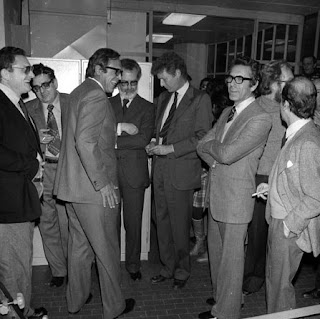NEW - Carlo Caracciolo - newspaper publisher
Left-leaning aristocrat who co-founded L’Espresso and La Repubblica
The newspaper publisher Carlo Caracciolo, who was the driving force behind the news magazine L’Espresso and the centre-left daily La Repubblica, was born on this day in 1925 in Florence. Caracciolo aligned himself politically with the Left and spent the last two years of World War Two fighting against the Fascists as a member of a partisan unit he joined at the age of 18. Yet he was born into Italian aristocracy, inheriting the titles Prince of Castagneto and Duke of Melito with the death of his father in 1965. After his younger sister, Marella, married the Fiat chairman, Gianni Agnelli, in 1953, he became one of the best connected individuals in Italian society. His funeral in 2008 was attended by members of five of Italy’s most powerful dynasties: Agnelli, Caracciolo, Borghese, Visconti and Pasolini. Tall and handsome, effortlessly elegant in his dress sense and instinctively well-mannered, he could not disguise his refined roots but never flaunted them. He was at his most comfortable in the company of left-wing intellectuals and insisted he be known only as Carlo. At the same time, however, he was a formidable businessman. Read more…
__________________________________________________________
Francesco Foscari – Doge of Venice
Ignominious ending to a long and glorious reign
After 34 years as Doge of Venice, Francesco Foscari was abruptly forced to leave office on this day in 1457. Stripped of his honours, he insisted on descending the same staircase from the Doge’s Palace that he had climbed up in triumph more than a third of a century before, rather than leave through a rear entrance. Eight days later the former Doge was dead. The story behind the downfall of Foscari and his son, Jacopo, fascinated the poet Lord Byron so much during his visit to Venice in 1816 that he later wrote a five-act play about it. This play, The Two Foscari: An Historical Tragedy, formed the basis of Verdi’s opera, I Due Foscari, and ensured that the sad story of the father and son was never forgotten. Francesco Foscari, who was born in 1373, was the 65th Doge of the Republic of Venice. He had previously served the Republic in many roles, including as a member of the Council of Forty and the Council of Ten, Venice’s ruling bodies, and as Procurator of St Mark’s. He was elected Doge in 1423, after defeating the other candidate, Pietro Loredan. As Doge he led Venice in a long series of wars against Milan. Read more…
__________________________________________________________
Alex Zanardi - racing driver and Paralympian
Crash victim who refused to be beaten
Alessandro 'Alex’ Zanardi, a title-winning racing driver who lost both legs in an horrific crash but then reinvented himself as a champion Paralympic athlete, was born on this day in 1966 in the small town of Castel Maggiore, just outside Bologna. Zanardi was twice winner of the CART series - the forerunner of IndyCar championship of which the marquee event is the Indianapolis 500 - and also had five seasons in Formula One. But in September 2001, after returning to CART following the loss of his contract with the Williams F1 team, Zanardi was competing in the American Memorial race at the EuroSpeedway Lausitz track in Germany when he lost control of his car emerging from a pit stop and was struck side-on by the car of the Canadian driver Alex Tagliani. The nose of Zanardi’s car was completely severed as Tagliani's car slammed into Zanardi's cockpit, just behind the front wheel, and the Italian driver suffered catastrophic injuries. Rapid medical intervention saved his life after he lost almost 75 per cent of his blood volume but both legs had to be amputated, one at the thigh and the other at the knee. Read more…
__________________________________________________________
Saint John of Capistrano
Patron saint of lawyers and chaplains
The feast day of Saint John of Capistrano (San Giovanni da Capestrano) is being celebrated today in Abruzzo and is marked by Catholics in the rest of Italy and the world. The patron saint of the legal profession and military chaplains, St John is particularly venerated in Austria, Hungary, Poland and Croatia as well as in different parts of America. St John was born in Capestrano, about halfway between L’Aquila and Pescara in the Abruzzo region of Italy, in 1386. He studied law at the University of Perugia and was then appointed Governor of Perugia by King Ladislaus of Naples. When war broke out between Perugia and the Malatesta family in 1416, John was sent to broker peace, but ended up in prison. While in captivity he decided not to consummate his recent marriage but to study theology instead. He entered the Order of Friars Minor at Perugia in 1416 and a few years later began preaching all over Italy as a Franciscan friar. He was particularly effective in Germany, Austria, Croatia and Poland and, because the churches were not big enough for his audiences, he had to preach in public squares. Read more…



























